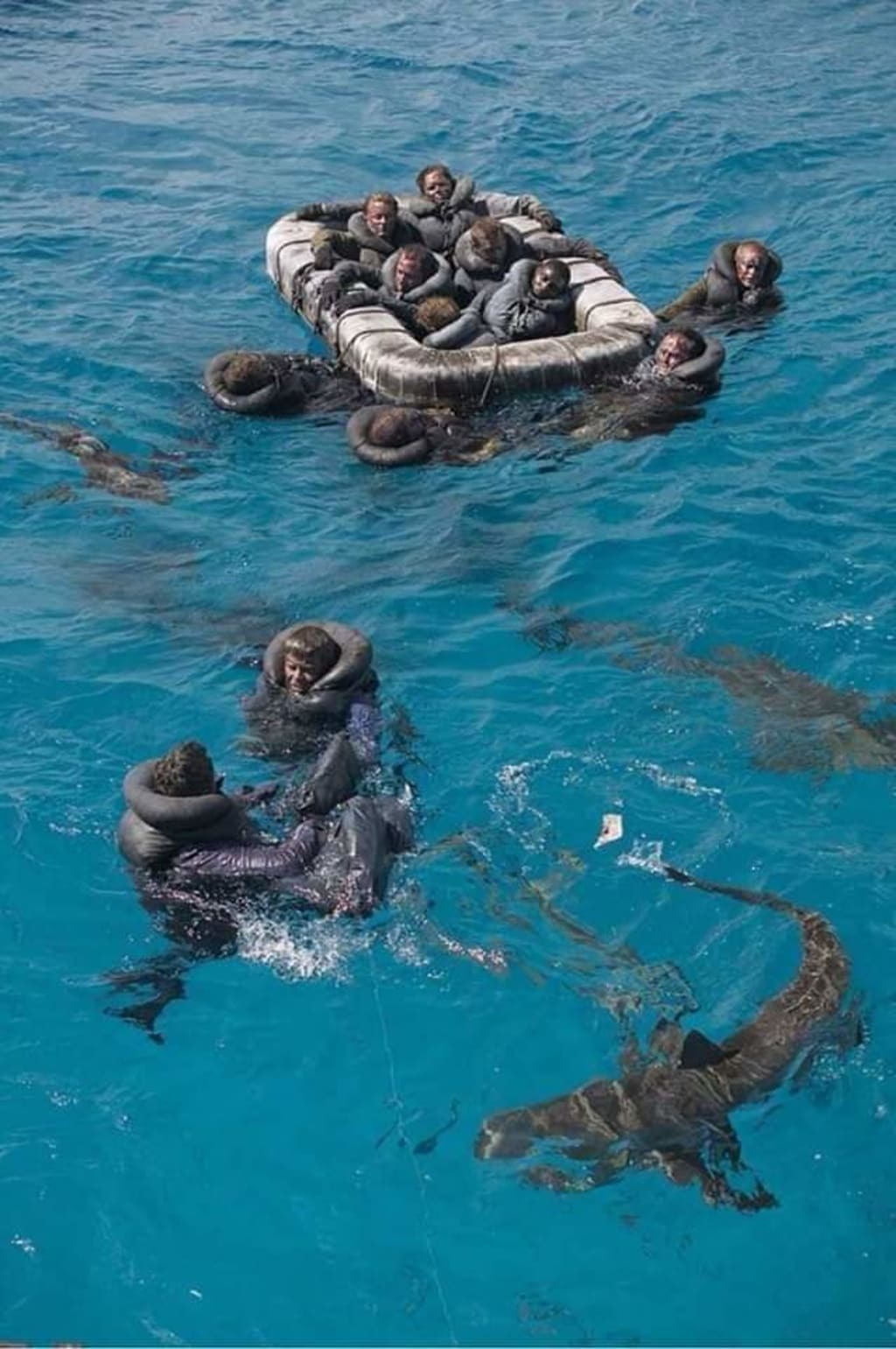Worst shark attack: A Tale of Survival and Sacrifice
The worst shark attack in history.

On July 30, 1945, the USS Indianapolis, a heavy cruiser of the United States Navy, faced one of the most harrowing and tragic events in naval history. Struck by two Japanese torpedoes in the Philippine Sea, the ship sank in a mere 12 minutes, leaving around 900 sailors stranded in shark-infested waters. The ensuing days were a relentless battle for survival, marked by the horrors of injury, dehydration, and predatory sharks. This blog post delves into the catastrophic sinking of the USS Indianapolis, the incredible stories of the survivors, and the lasting impact of this maritime tragedy.
The USS Indianapolis: A Mission of Vital Importance
The USS Indianapolis had just completed a top-secret mission, delivering critical components of the atomic bomb "Little Boy" to the island of Tinian, which would later be dropped on Hiroshima. After the successful delivery, the ship was en route to Leyte Gulf in the Philippines when disaster struck.
In the early hours of July 30, 1945, the cruiser was sailing unescorted through the Philippine Sea. Despite the clear night and calm seas, the ship was detected by the Japanese submarine I-58, commanded by Mochitsura Hashimoto. The submarine launched a salvo of six torpedoes, two of which found their target. The first torpedo hit the bow of the ship, while the second struck near the midsection, igniting a magazine and causing catastrophic damage.
The Sinking and Immediate Aftermath
The impact of the torpedoes was devastating. The initial explosions caused massive structural damage, and the ship began to list heavily. Within 12 minutes, the USS Indianapolis slipped beneath the waves, taking approximately 300 crew members down with her. The remaining 900 sailors were cast into the open sea, many with severe injuries.
The survivors were left floating in the water with few lifeboats, life vests, or supplies. The chaos of the sinking had scattered the men across a wide area, making it difficult for them to regroup. Burnt, mutilated, and with limbs severed by the explosions, the sailors faced a dire and desperate situation. However, their ordeal was far from over.
The Shark Attacks Begin
As the sun rose on July 30, the true horror of their situation became apparent. The warm waters of the Philippine Sea were infested with sharks, primarily oceanic whitetips known for their aggressive behavior. Drawn by the commotion and the scent of blood, the sharks began circling the men.
For the next four days, the survivors endured relentless shark attacks. According to the most conservative estimates, at least 150 sailors were killed by these predators. The attacks were often sudden and ferocious, with sharks dragging men underwater before the eyes of their horrified comrades. The psychological torment of waiting for the next attack took a tremendous toll on the sailors, many of whom were already battling severe injuries, dehydration, and exposure.
The Struggle for Survival
Beyond the immediate threat of sharks, the survivors faced other daunting challenges. The tropical sun beat down mercilessly, causing severe sunburn and dehydration. Many men succumbed to hyperthermia or suffered hallucinations due to the lack of fresh water. The saltwater and oil from the ship's wreckage exacerbated their wounds, leading to infections.
In these dire conditions, camaraderie and leadership played crucial roles in maintaining morale and survival. Some survivors recalled how certain individuals took charge, organizing makeshift rafts and rationing the few supplies they had. Despite the bleak situation, acts of bravery and selflessness were common. Sailors shared their limited resources, tended to each other's wounds, and provided emotional support to keep hope alive.
The Rescue Operation
The plight of the USS Indianapolis survivors might have remained unknown for much longer if not for a fortunate twist of fate. On August 2, 1945, a PV-1 Ventura bomber piloted by Lieutenant Wilbur Gwinn happened to spot an oil slick from the air. Upon closer inspection, Gwinn realized that men were floating in the water. He immediately radioed for help, and the Navy dispatched rescue aircraft and ships to the scene.
The first rescue aircraft arrived later that day, dropping life rafts and supplies to the survivors. The sight of these planes brought a glimmer of hope to the men who had been adrift for days. By August 3, the rescue ships reached the area, pulling the exhausted and traumatized sailors from the water. Of the approximately 900 men who had survived the initial sinking, only 316 were still alive.
Aftermath and Legacy
The rescue of the USS Indianapolis survivors marked the end of a horrific ordeal, but the story was far from over. The incident prompted significant scrutiny and controversy. Questions arose about why the ship's distress signal had not been acted upon and why the Navy had taken so long to mount a rescue operation. It was later revealed that the ship's mission had been so secretive that its movements were not closely monitored, contributing to the delayed response.
Captain Charles B. McVay III, who had commanded the USS Indianapolis, was court-martialed and convicted of "hazarding his ship by failing to zigzag." Many believed this was an unjust decision, arguing that McVay was being used as a scapegoat for broader systemic failures. In 2000, after years of advocacy by survivors and their families, Captain McVay was posthumously exonerated by the U.S. Congress.
The story of the USS Indianapolis has been immortalized in various forms of media, including books, documentaries, and films. The most famous recounting was by actor Robert Shaw in the 1975 movie "Jaws," where his character, Quint, shares a haunting monologue about the shark attacks following the sinking.
Honoring the Heroes
The legacy of the USS Indianapolis is one of bravery, sacrifice, and resilience. The survivors' harrowing experiences highlight the perilous nature of naval warfare and the extraordinary endurance of the human spirit. Memorials and monuments have been established to honor the men who lost their lives and those who survived the ordeal. The story serves as a poignant reminder of the costs of war and the importance of preparedness and vigilance.
In recent years, efforts have been made to preserve the memory of the USS Indianapolis and educate future generations about this significant event in naval history. Survivor reunions, historical exhibits, and educational programs ensure that the lessons learned from this tragedy continue to resonate.
Conclusion
The sinking of the USS Indianapolis and the subsequent ordeal faced by its crew remains one of the most compelling and tragic stories of World War II. The bravery and resilience displayed by the survivors, coupled with the enduring legacy of the event, serve as powerful reminders of the human capacity for endurance and heroism in the face of unimaginable adversity. As we honor the memory of those who perished and those who survived, we are reminded of the sacrifices made by countless individuals during times of war and the importance of preserving their stories for future generations.
About the Creator
Enjoyed the story? Support the Creator.
Subscribe for free to receive all their stories in your feed. You could also pledge your support or give them a one-off tip, letting them know you appreciate their work.






Comments (3)
Niceee
on a side thought, why did you place this under PetLife?
My dad's ship was there. They were lucky and endured only minor damage but the nightmare of seeing so many of their fellow sailors being eaten by sharks was something he only spoke of when he was drunk, which thankfully wasn't often. He called it "Sailors Hell" and often said he'd rather be one of the eaten than watch those who were.